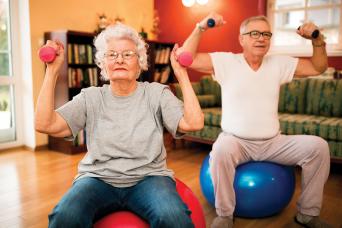
Health & Wellness Committee: Exercise and a Safer Home Can Help Your Balance
As with many aspects of our health and fitness, balance is something we take for granted — until it becomes a problem. Somehow it just sneaks up on you, maybe when you’re trying to sit down to put your pants on, or using the arms of a chair to get up. Perhaps you’ve limited your activities because of a fear of falling.
Many systems in the body contribute to our sense of balance, but like a muscle, balance can be strengthened with various exercises. Additionally, many falls can be prevented with interventions such as medication management and home modifications. A multi-pronged approach is your best bet.
Time to Take a Balance Test
There are several methods used to test balance, but one of the easiest is to time how long you can stand on one leg. Stand near a sturdy object for safety (such as the kitchen counter) and raise one foot. Count how many seconds you can remain still while balancing on one leg. For each decade of life, there are statistical norms, but aiming for 30 seconds regardless of your age is a great goal.
Easy Exercises to Boost Your Balance and Confidence
Exercises done while standing are best. Stand near a sturdy object for safety, raise one leg (bent at the hip and knee), and slowly swing it forward and back. If you need to hold on as you do this, see if over time you can lighten your grip. Gradually try to use just one hand. Eventually, experiment with not holding on at all.
Next, imagine you are standing in the center of a large clock that’s drawn on the floor. While standing tall, slowly move your right foot from the 12 to the 6, touching on each number as you go, and return. Repeat this with your left leg. Work toward being able to do this leg clock exercise while hovering your foot over each number.
Lastly, practice getting up and down from a seated position without the use of your hands. There are many opportunities to do this every day, and it will strengthen your legs. Many studies have shown that weak legs are a major risk factor for falls.
Make Your Home a Safer Place
Most accidents occur around the house, especially the bathroom. Installing grab bars, using non-slip mats or adhesive strips inside the tub and on the floor, and considering using a shower seat can all be very helpful. Removing clutter from the floor, placing pet food bowls out of walkways, fixing loose (or absent) stair rails, and addressing poor lighting will also go a long way toward having a safer home.
Talk to Your Doctor About Medication Management
Several medications can cause dizziness, drowsiness, or lower reaction times, such as those taken for sleep disorders, anxiety, high blood pressure, or chronic pain. These side effects can intensify as we get older, and taking multiple medications increases the risk. Speak with your doctor to get a better understanding of how you can lower your fall risk.
It’s Never Too Early to Start
According to the Center for Disease Control and Prevention, falls are the leading cause of injury and death among Americans over 65. Our sense of balance is highly trainable; find ways to practice in everyday activities. Now is the time to start balance training in order to stay steady in later years.
Joanne Fagerstrom, PT, CFP, has more than 40 years of experience as a physical therapist and is the owner of Mindful Physical Therapy, LLC in Wyndmoor. She will be offering a workshop called “Better Balance” at her studio Tuesday, Sept. 17.

